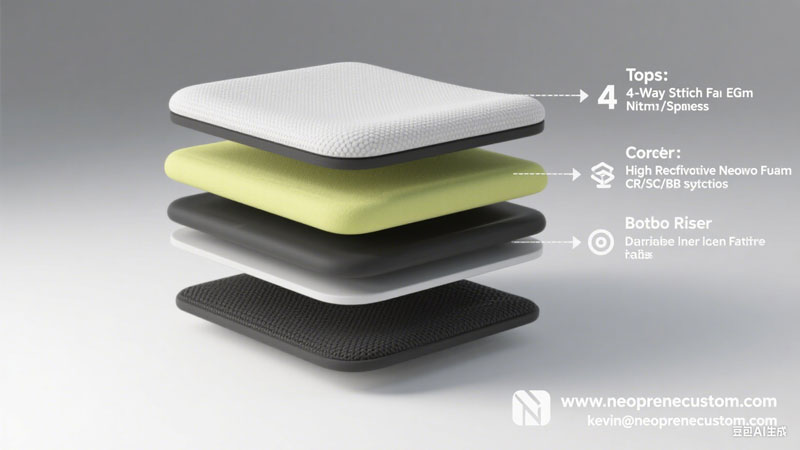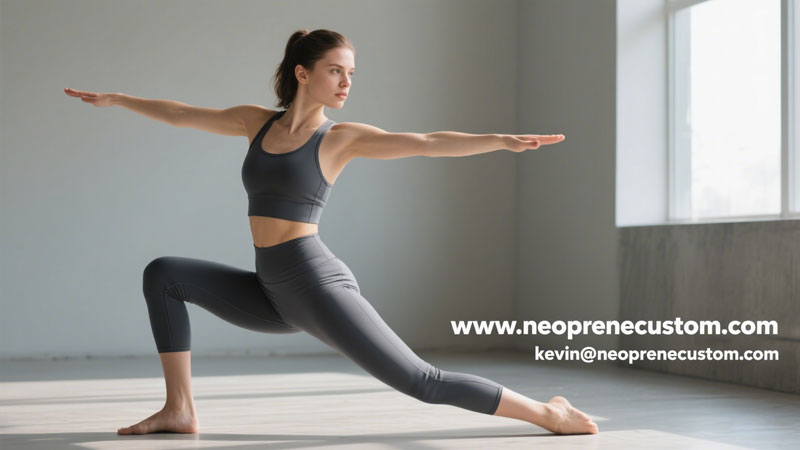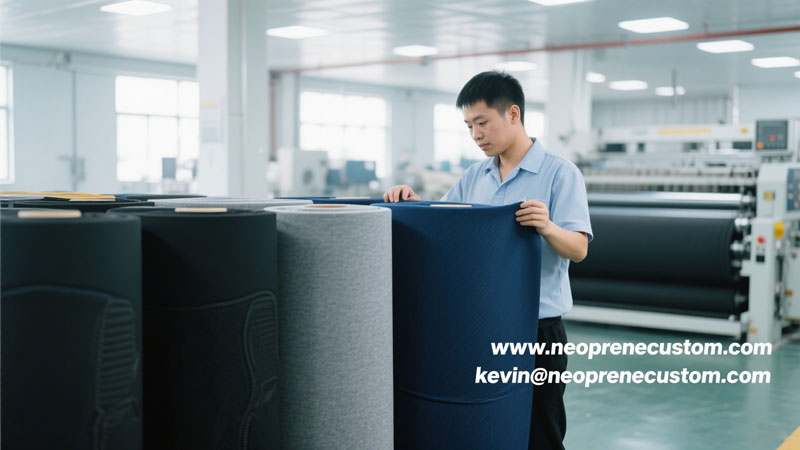Is Your Next Blockbuster Product Being Held Back by the Wrong Fabric Choice? A Definitive Guide from a Core Neoprene Manufacturer.
Are you sitting at your desk right now, staring at a screen filled with specification sheets from various suppliers, feeling a sense of creeping confusion? CR, SBR, SCR… what do these cryptic acronyms truly mean for your end product? 2mm, 3mm, or is it 5mm—which thickness will actually work for your design? Nylon laminate, Polyester laminate, or a "super-stretch" blend… does the difference really matter that much?
Welcome to what is arguably the most critical, yet most profoundly misunderstood, stage of product development: material selection. This is the very juncture where your product’s destiny is forged. It’s the decision point that separates a market champion from a fleeting "beta test." The wrong choice can lead to a cascade of failures: underperforming products, a surge in customer complaints, and irreparable damage to your brand's reputation. The right choice, however, can give your designs wings, delivering unparalleled performance, sublime comfort, and bulletproof durability that will capture the loyalty of consumers.
So, here is the question: do you want to continue navigating this ocean of information alone, crossing your fingers and hoping you make the right call? Or would you prefer an experienced guide to illuminate the path forward, leading you effortlessly through this seemingly complex jungle of material science?
As a dedicated factory specializing in the custom manufacturing of neoprene for years, we see ourselves as more than just a vendor on your purchase order. We are your technical partners, your collaborators, and your solution providers on this journey of creation. Today, we aren't here to sell you a specific roll of fabric. Instead, we are going to pull back the curtain and share our internal decision-making framework with you. Through a clear, five-step guide, we will teach you how to think, question, and choose like a true industry expert, ensuring you select the absolute best neoprene fabric for your project.
Are you ready to say goodbye to decision paralysis for good? Let's begin.
Step 1: Define Your Battlefield – Application Is Everything
Before we even begin to discuss the molecular structure of rubber, we must first discuss your customer. Who are they? What will they be doing while wearing your product? Because discussing materials in a vacuum, divorced from their application, is an exercise in futility. Can you imagine sending a deep-sea diver on a mission wearing a pair of yoga pants? The context dictates the requirements.
Are you designing for extreme water sports (e.g., diving wetsuits, surfing suits, kiteboarding gear)?
What are the non-negotiable core needs? Thermal insulation against cold water, resistance to hydrostatic pressure at depth, resilience against saltwater and UV degradation, and extreme flexibility and durability during high-intensity movements.
So, what should you focus on? You must prioritize closed-cell neoprene foam for maximum thermal and water insulation. The thickness will be a primary concern (dictated by water temperature), and you should, without question, be looking at materials with a CR (Chloroprene Rubber) core. Why? Because CR provides the most superior rebound, durability, and resistance to environmental erosion. Any compromise here doesn't just affect comfort; it can impact user safety and the fundamental performance of the product.
Is your target land-based, high-intensity fitness (e.g., compression wear, CrossFit apparel, running gear)?
What are the critical performance metrics? Consistent muscle support (meaning sustained compressive force), rapid moisture wicking and breathability, high abrasion resistance, and, most importantly, an exceptional stretch recovery that prevents bagging and deformation after repeated use.
So, what should you focus on? A core of SCR (a CR/SBR blend) or even a high-performance CR is ideal to balance performance and cost. Fabric breathability becomes a key factor; you might even consider our perforation services for enhanced airflow in high-sweat zones. The laminated fabric needs to be a highly durable nylon or, more likely, a four-way stretch fabric with a high spandex content to work in concert with the body's movements.
Is the product intended for studio and lifestyle scenarios (e.g., yoga pants, Pilates apparel, premium athleisure)?
What defines success in this category? A "second-skin" feeling of supreme comfort, unrestricted four-way stretch, an elegant aesthetic and texture, and the ability to retain its shape and fit after countless wash cycles.
So, what should you focus on? Thinner materials, typically in the 1mm-2mm range, are preferred. A core of high-CR-content SCR or pure CR is highly recommended to ensure the best softness and shape memory. The choice of laminated fabric is paramount here. A soft, skin-friendly nylon or polyester blend, perhaps with a matte finish or a unique texture, can dramatically elevate the perceived value of your product.
Is your domain medical and protective gear (e.g., knee braces, wrist supports, orthopedic devices)?
What are the primary functional demands? Precise support and compression, a degree of therapeutic warmth (insulation), and long-term comfort and durability for prolonged skin contact.
So, what should you focus on? SBR or SCR is often the most sensible choice, offering a great balance of performance and cost-effectiveness. Here, a special type of laminated fabric called UBL (Unbroken Loop) might be your best friend. Its surface is a durable loop fabric that allows hook-and-loop fasteners (like Velcro) to attach securely anywhere, providing adjustable and customized support.
Now, ask yourself again: where is my product's "battlefield"? Once you have a crystal-clear definition of this, the subsequent choices become incredibly straightforward. And if you're still wrestling with a unique or hybrid application, that is precisely why we exist. Feel free to send your most ambitious ideas to kevin@neoprenecustom.com, and we will help you translate that vision into a tangible material solution.
Step 2: Choose Your 'Heart' – Performance Lives in the Foam Core (CR vs. SBR vs. SCR)
If a sheet of neoprene fabric is a high-performance sports car, then the raw rubber foam itself is its engine. Different engines deliver vastly different levels of power, endurance, and reliability.
CR (Chloroprene Rubber): The Undisputed Performance King
What is it? It is a polymer of chloroprene, resulting in a molecular structure that is inherently stable and packed with superior physical properties. Think of it as the "special forces" of the rubber world.
Why would you choose it? When your product absolutely must have the best stretch recovery, the longest-lasting durability, and the highest resistance to oils, chemicals, ozone, and weathering, CR is not just an option; it's a necessity. It is the bedrock of professional-grade, competition-level products. Investing in CR is investing in your product's longevity and your brand's reputation. Do you want your brand to be synonymous with "peak performance"? If the answer is yes, then your answer is CR.
SBR (Styrene Butadiene Rubber): The Cost-Effective Workhorse
What is it? This is a high-volume, low-cost synthetic rubber, a copolymer of styrene and butadiene, widely used in industrial applications like tires.
Why would you choose it (or avoid it)? SBR's main advantage is very clear: it's inexpensive. It provides decent cushioning and some elasticity. However, its disadvantages can be critical for high-performance applications: its stretch recovery is significantly inferior to CR, meaning it's prone to "packing out" or becoming permanently stretched after repeated use. Its resistance to weathering and aging is also poor. Would you ever use it for a premium wetsuit? Absolutely not. But is it useless? Of course not. For laptop sleeves, mouse pads, promotional can coolers, or low-demand protective gear, it's an entirely reasonable and economical choice.
SCR: The Intelligent Hybrid Solution
What is it? This is where our value as a custom factory truly shines. SCR isn't a single, fixed product. It is the result of us blending CR and SBR in varying ratios to create a new material with a targeted performance profile.
Why would you choose it? Because not every product needs 100% of CR's performance or needs to bear 100% of its cost. Are you looking for a fabric for a mid-to-high-end fitness garment that dramatically outperforms SBR but is more attractively priced than pure CR? We can engineer an SCR material for you with a 30% CR content, a 50% content, or a 70% content. This is a strategic choice, a way to perfectly balance your performance goals with your budget constraints. At https://neoprenecustom.com, we don't believe in "one-size-fits-all" solutions; we provide bespoke engineering.

Step 3: Calibrate the 'Physique' – The Subtle Art of Balancing Thickness
Thickness, measured in millimeters (mm), is about much more than just warmth. It directly impacts a fabric's flexibility, supportive structure, buoyancy, and overall weight. Choosing the wrong thickness is like trying to run a marathon in shoes that are two sizes too big.
0.5mm - 1.5mm (The Featherweights): Almost like a second skin. Best suited for lightweight rash guards, the outer layers of triathlon suits, paneling in yoga wear, or as an accent in fashion apparel. They offer maximum flexibility with minimal thermal insulation.
2mm - 3mm (The All-Rounders): This is the most common and versatile thickness range. It's perfect for warm-water wetsuits, the vast majority of fitness apparel, laptop sleeves, and general sports braces. It strikes an excellent balance between flexibility, insulation, and structural support. If you're unsure where to begin, this is often a safe and effective starting point.
4mm - 5mm (The Thermal Guards): Specifically engineered for colder water conditions. Ideal for cool-water wetsuits and surfing gear. They provide a significant boost in insulation and buoyancy, but with a corresponding decrease in flexibility. This is where the inherent rebound of the material (the advantage of CR) becomes crucial to counteract the stiffness of the added thickness.
6mm+ (The Extreme Fortresses): Reserved for very cold or extreme environments like commercial diving or ice diving. This range offers elite thermal protection but with limited flexibility, and is typically used for professional applications where range of motion is a secondary concern.
Remember, the thickness we refer to is that of the foam core itself. The final thickness of your product will include the two laminated fabrics on either side. It's a small detail that is often overlooked, but our team at https://neoprenecustom.com will calculate this precisely for you.

Step 4: Select Your 'Armor' – The Critical Role of Laminated Fabrics
The raw neoprene foam core is vulnerable. The fabric laminated to its surface not only protects this core but also defines the product's final look, feel, stretch characteristics, and durability.
Nylon: The classic, most durable choice. Its abrasion resistance is excellent, and it offers good stretch, making it the standard-issue choice for most wetsuits and braces. But did you know there are different grades of nylon, from "standard stretch" to "high stretch"? We can provide various options based on your flexibility requirements.
Polyester (Poly): When color and graphics are king, polyester is your champion. It is superior for sublimation printing, producing vibrant, long-lasting colors that are more UV-resistant than nylon. This makes it ideal for fashion-forward athleisure and yoga apparel that features complex patterns.
Spandex (Lycra®) Blends: This is the source of "super stretch." We often refer to these as "4-way stretch" fabrics. Marrying a high-spandex fabric to our high-recovery foam core creates the ultimate performance monster, capable of accommodating any extreme movement. Do you want that uninhibited, "one-with-your-body" experience for your customers? This is how you achieve it.
Specialty Functional Fabrics:
UBL (Unbroken Loop): The surface is a durable, non-breaking loop fabric that allows hook-and-loop fasteners to be attached and re-attached endlessly without pilling or damage. It's the perfect partner for adjustable medical braces.
Smooth Skin / Mesh Skin: This isn't a fabric but rather a special finish on the rubber surface itself. It is hydrophobic and wind-resistant, reducing the wind-chill effect from water evaporation. It's commonly found on the chest and back panels of high-end wetsuits.
Titanium Coating: A micro-thin layer of metal is applied to the rubber surface, which reflects body heat inward, allowing for better insulation with a thinner, more flexible material.
As your custom manufacturing partner, we can create almost any combination you can imagine. Do you need a durable nylon exterior with a soft, skin-friendly polyester interior? No problem. Do you want to emboss your brand's exclusive pattern onto the fabric? We can do that too. Explore the infinite possibilities at https://neoprenecustom.com.

Step 5: The Finishing Touches – Special Processes That Make Your Product Stand Out
When everyone is using a similar base material, how do you differentiate your product? The answer lies in the details—the value-added processes.
Perforation: We punch tiny, precisely spaced holes through the neoprene. Why? For engineered breathability. For products that need support and insulation but are used in high-sweat scenarios (like the back of a knee brace), this is a revolutionary improvement in comfort.
Embossing: We use heat and custom molds to press patterns or logos into the fabric surface. This not only adds a sophisticated aesthetic but can also provide functional benefits like enhanced grip or anti-slip properties.
Printing: From simple screen-printed logos to full-panel, photorealistic digital printing, we can transfer your visual identity directly onto the fabric, making your product uniquely yours.
Conclusion: Stop Guessing. Start Engineering with an Expert.
Let's circle back to our original question. How do you choose the right neoprene fabric?
The answer is now clear: it is a systematic, multi-dimensional decision-making process. It requires you to deeply understand your application, wisely choose your core foam, precisely calibrate the thickness, carefully select the laminated fabrics, and creatively use special processes to build a competitive edge.
You can, of course, attempt to do all of this yourself. But the path is filled with potential pitfalls that can consume vast amounts of your time, budget, and prototyping resources.
So, we'd like to propose a much better question: Why wouldn't you just partner with the experts in the field?
At https://neoprenecustom.com, our entire existence is dedicated to helping brands and developers just like you transform complex material science into commercially successful products. We don't just provide rolls of fabric; we provide decades of collective experience, a collaborative development model, and an unwavering commitment to final quality.
Don't let material selection be a roadblock on your path to innovation. Let it be the cornerstone of your success.
Take the next step. Send your project concept, your technical questions, or even just your initial ideas directly to our lead consultant, Kevin, at his email: .
Together, starting with the very first, perfectly chosen piece of fabric, let's build your next blockbuster product.
Contact: Kevin
Phone: 13417385320
Tel: 0734-87965514
Email: kevin@neoprenecustom.com
Add: Intersection of Zhangjialing Road and Science and Technology Road, Guiyang Industrial Park, Guiyang Town, Qidong County, Hengyang City, Hunan Province./Dongguan Factory(Louvcraft): Building 3, No.363 Dongxing West Road Dongkeng, Dongguan.